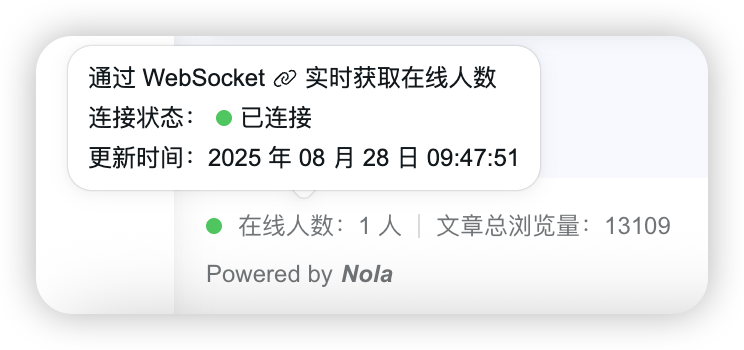目前 Nola 博客已经实现了此功能,在当前页面的页脚中即可看到。

本文记录一下使用 Ktor 后端 + Next.js 通过 WebSocket 实现前端页面在线人数的展示。
一、Ktor
1. 导入依赖
首先在 Ktor 中,导入 WebSocket 依赖:
// WebSocket
implementation("io.ktor:ktor-server-websockets:$ktor_version")
2. 启用 WebSocket 插件
新建一个 WebSocketPlugin.kt 文件,并写入下面的代码,配置 WebSocket 插件:
import io.ktor.server.application.*
import io.ktor.server.websocket.*
import kotlin.time.Duration.Companion.seconds
fun Application.configureWebSocket() {
install(WebSockets) {
// ping 之间的持续时间
pingPeriod = 30.seconds
// 超时时间
timeout = 15.seconds
// 帧最大大小
maxFrameSize = Long.MAX_VALUE
// 是否使用掩码
masking = false
}
}
然后在 Ktor 应用的 Application 上下文中启用该插件即可:
fun Application.module() {
// ... 其他插件配置
// WebSocket 配置
configureWebSocket()
}
3. 编写 Manager 类
新建一个 BlogOnlineManager 类,用于管理 WebSocket 的连接和记录当前在线人数。
同时限制了每个 IP 地址最多只能同时建立 5 个连接,第 6 个连接会被直接关闭,这里可以根据自己的需求进行修改。
import cc.loac.extensions.toJSONString
import io.ktor.websocket.WebSocketSession
import io.ktor.websocket.send
import kotlinx.coroutines.CoroutineScope
import kotlinx.coroutines.Dispatchers
import kotlinx.coroutines.Job
import kotlinx.coroutines.delay
import kotlinx.coroutines.launch
import kotlinx.coroutines.sync.Mutex
import kotlinx.coroutines.sync.withLock
import java.util.concurrent.ConcurrentHashMap
import java.util.concurrent.atomic.AtomicInteger
/**
* 博客前端在线人数数量管理
*/
class BlogOnlineManager private constructor() {
companion object {
@Volatile
private var instance: BlogOnlineManager? = null
private var ioScope = CoroutineScope(Dispatchers.IO)
// 定时任务
private var job: Job? = null
/**
* 获取 Manager 实例
* @return 唯一 BlogOnlineManager 实例
*/
fun getInstance(): BlogOnlineManager {
return instance ?: synchronized(this) {
instance ?: BlogOnlineManager().also {
instance = it
if (job == null) {
// 启动定时任务
job = ioScope.launch {
// 每 30 分钟尝试清理一次无效连接
while (true) {
delay(1000 * 60 * 30)
instance?.cleanupDeadConnections()
}
}
}
}
}
}
}
private val connectionMutex = Mutex()
// 当前连接的 Session
private val connections = ConcurrentHashMap<String, WebSocketSession>()
// 在线人数
private val onlineCount = AtomicInteger(0)
// IP 连接计数,防止单个 IP 过多连接
private val ipConnectionCount = ConcurrentHashMap<String, AtomicInteger>()
// 每个 IP 最多只计算 5 个设备
private val maxConnectionsPerIp = 5
/**
* 添加连接
* @param sessionId Session ID
* @param session WebSocketSession
* @param clientIp 客户端 IP
* @return 是否添加成功(如果当前 IP 数量超过 5 个,则认为失败)
*/
suspend fun addConnection(
sessionId: String,
session: WebSocketSession,
clientIp: String
): Boolean {
return connectionMutex.withLock {
// 检查单个 IP 连接数限制
val ipCount = ipConnectionCount.computeIfAbsent(clientIp) { AtomicInteger(0) }
if (ipCount.get() >= maxConnectionsPerIp) {
return@withLock false
}
connections[sessionId] = session
ipCount.incrementAndGet()
val currentCount = onlineCount.incrementAndGet()
// 广播新的在线人数
broadcastOnlineCount(currentCount)
true
}
}
/**
* 移除连接
* @param sessionId Session ID
* @param clientIp 客户端 IP
*/
suspend fun removeConnection(sessionId: String, clientIp: String) {
return connectionMutex.withLock {
connections.remove(sessionId)
ipConnectionCount[clientIp]?.decrementAndGet()
val currentCount = onlineCount.decrementAndGet()
// 广播新的在线人数
broadcastOnlineCount(currentCount)
}
}
/**
* 广播在线人数
* @param count 在线人数
*/
private suspend fun broadcastOnlineCount(count: Int) {
val message = OnlineCount(
count = count,
timestamp = System.currentTimeMillis()
).toJSONString()
val deadConnections = mutableListOf<String>()
connections.forEach { (sessionId, session) ->
try {
session.send(message)
} catch (_: Exception) {
// 记录死连接,稍后清理
deadConnections.add(sessionId)
}
}
// 清理死连接
deadConnections.forEach { sessionId ->
connections.remove(sessionId)
onlineCount.decrementAndGet()
}
}
/**
* 获取当前连接数量
*/
fun getCurrentCount(): Int = onlineCount.get()
/**
* 清理无效连接
*/
suspend fun cleanupDeadConnections() {
connectionMutex.withLock {
val deadConnections = mutableListOf<String>()
connections.forEach { (sessionId, session) ->
try {
// 发送心跳检测
session.send("ping")
} catch (_: Exception) {
deadConnections.add(sessionId)
}
}
deadConnections.forEach { sessionId ->
connections.remove(sessionId)
onlineCount.decrementAndGet()
}
}
}
}
/**
* 在线人数响应类
* @param count 人数
* @param timestamp 时间戳毫秒
*/
data class OnlineCount(
val count: Int,
val timestamp: Long
)
4. 编写路由
在路由中新建 WebSocket 路由,代码如下所示:
webSocket("online") {
// 每个连接的唯一 UUID
val sessionId = UUID.randomUUID().toString()
// 客户端 IP
val clientIp = call.request.origin.remoteHost
// 获取 Manager 实例
val manager = BlogOnlineManager.getInstance()
// 验证并发起连接
if (!manager.addConnection(sessionId, this, clientIp)) {
close(CloseReason(CloseReason.Codes.CANNOT_ACCEPT, "来自 $clientIp 的连接太多"))
return@webSocket
}
try {
// 处理客户端消息
for (frame in incoming) {
// 这里只处理了客户端的心跳消息,其他任何来自客户端的消息均忽略
when (frame) {
is Frame.Text -> {
// 回复客户端心跳消息
val text = frame.readText()
if (text == "ping") {
send(Frame.Text("pong"))
}
}
is Frame.Close -> {
break
}
else -> {}
}
}
} catch (_: ClosedReceiveChannelException) {
// 连接正常关闭
} catch (e: Exception) {
// .error() 是一个日志打印扩展函数,用于打印错误日志
e.localizedMessage.error()
} finally {
// 客户端断开和发生错误时移除 WebSocket 连接
manager.removeConnection(sessionId, clientIp)
}
}
5. (可选)限流器
上面已经实现了 WebSocket 计数的功能,如果想要实现对该 WebSocket 接口请求速度进行限制,可以使用 Ktor 的一个官方插件 Rate Limit。
首先导入 Rate Limit 依赖:
// 接口访问速率限制
implementation("io.ktor:ktor-server-rate-limit:$ktor_version")
新建一个RateLimitPlugin.kt 文件用于配置 Rate Limit:
import io.ktor.server.application.*
import io.ktor.server.plugins.origin
import io.ktor.server.plugins.ratelimit.*
import kotlin.time.Duration.Companion.minutes
import kotlin.time.Duration.Companion.seconds
/** 在线人数 WebSocket 限流器 **/
val LIMITER_ONLINE_COUNT_WB = RateLimitName("LIMITER_ONLINE_COUNT_WB")
/**
* 配置接口速率限制插件
*/
fun Application.configureRateLimit() {
install(RateLimit) {
// 全局限制器
global {
rateLimiter(limit = 300, refillPeriod = 60.seconds)
}
// 在线人数 WebSocket 限流器
register(LIMITER_ONLINE_COUNT_WB) {
// 每分钟内最多请求 10 次
rateLimiter(limit = 10, refillPeriod = 1.minutes)
// 使用客户端 IP 作为 Key
requestKey { call ->
call.request.origin.remoteHost
}
}
}
}
接着在 Ktor 应用的 Application 上下文中启用插件:
fun Application.module() {
// ... 其他插件配置
// WebSocket 配置
configureWebSocket()
// 接口访问速率限制配置
configureRateLimit()
}
随后在 WebSocket 的路由外套上 rateLimit()方法,即可实现对 WebSocket 接口的限流:
// 限流器,LIMITER_ONLINE_COUNT_WB 是上面在 RateLimit 插件中定义的规则
rateLimit(LIMITER_ONLINE_COUNT_WB) {
webSocket("online") {
// WebSocket 路由体
}
}
二、Next.js
1. 定义 Hook
在 Next.js 中,使用一个 Hook 来处理 WebSocket 连接和响应。
新建一个 useOnlineCount.ts 方法:
import { useEffect, useRef, useState } from 'react';
import { OnlineCountResponse } from '@/models/response/OnlineCountResponse';
/**
* 获取当前博客在线人数 Hook
*/
export const useOnlineCount = () => {
// 当前人数
const [onlineCount, setOnlineCount] = useState<number>(0);
// 更新时间戳
const [updateTime, setUpdateTime] = useState<number>(0);
// WebSocket Ref
const wsRef = useRef<WebSocket | null>(null);
useEffect(() => {
// 创建 WebSocket 连接
// WebSocket 服务器地址(ws:// 或者 wss:// 开头,取决于是否启用了 HTTPS)
// 例如:ws://localhost:8098, wss://loac.cc
const serverUrl = process.env.NEXT_PUBLIC_WEBSOCKET_URL;
if (!serverUrl) {
setOnlineCount(-1)
setUpdateTime(-1)
console.error('WEBSOCKET_URL is not defined');
return;
}
// 上面在 Ktor 中定义的 WebSocket 路由地址
const wsUrl = `${serverUrl}/online`;
// 创建 WebSocket 连接
const ws = new WebSocket(wsUrl);
wsRef.current = ws;
// 监听服务器消息
ws.onmessage = (event) => {
try {
if (String(event.data) == 'ping') {
// 服务器向客户端发送 ping,无需处理
} else {
// 收到在线人数数据
const data: OnlineCountResponse = JSON.parse(event.data);
setOnlineCount(data.count);
setUpdateTime(data.timestamp)
}
} catch (error) {
setOnlineCount(-1)
setUpdateTime(-1)
console.error(`WebSocket 解析消息失败:${error}`);
}
};
ws.onopen = () => {
// 连接成功
}
ws.onclose = () => {
console.log('WebSocket 连接已关闭');
setOnlineCount(-1)
setUpdateTime(-1)
}
ws.onerror = (error) => {
console.error(`WebSocket 错误:${error}`);
setOnlineCount(-1)
setUpdateTime(-1)
}
// 页面卸载时关闭连接
const handleBeforeUnload = () => {
ws.close();
}
window.addEventListener('beforeunload', handleBeforeUnload)
return () => {
ws.close();
window.removeEventListener('beforeunload', handleBeforeUnload)
}
}, []);
return onlineCount
};
2. 使用 Hook
Hook 定义完成后,就可以在页面上进行展示了,下面是一个例子:
'use client';
import { useOnlineCount } from '@/hooks/useOnlineCount';
/**
* 博客在线人数显示组件
*/
export default function OnlineCounter() {
const { onlineCount, updateTime } = useOnlineCount();
return (
<div>
<p>当前在线人数:{onlineCount} 人</p>
{/*formatDate() 是一个将时间戳毫秒转换为字符串的方法*/}
<p>更新时间:{updateTime > 0 ? formatDate(updateTime) : '未知'}</p>
</div>
);
}
